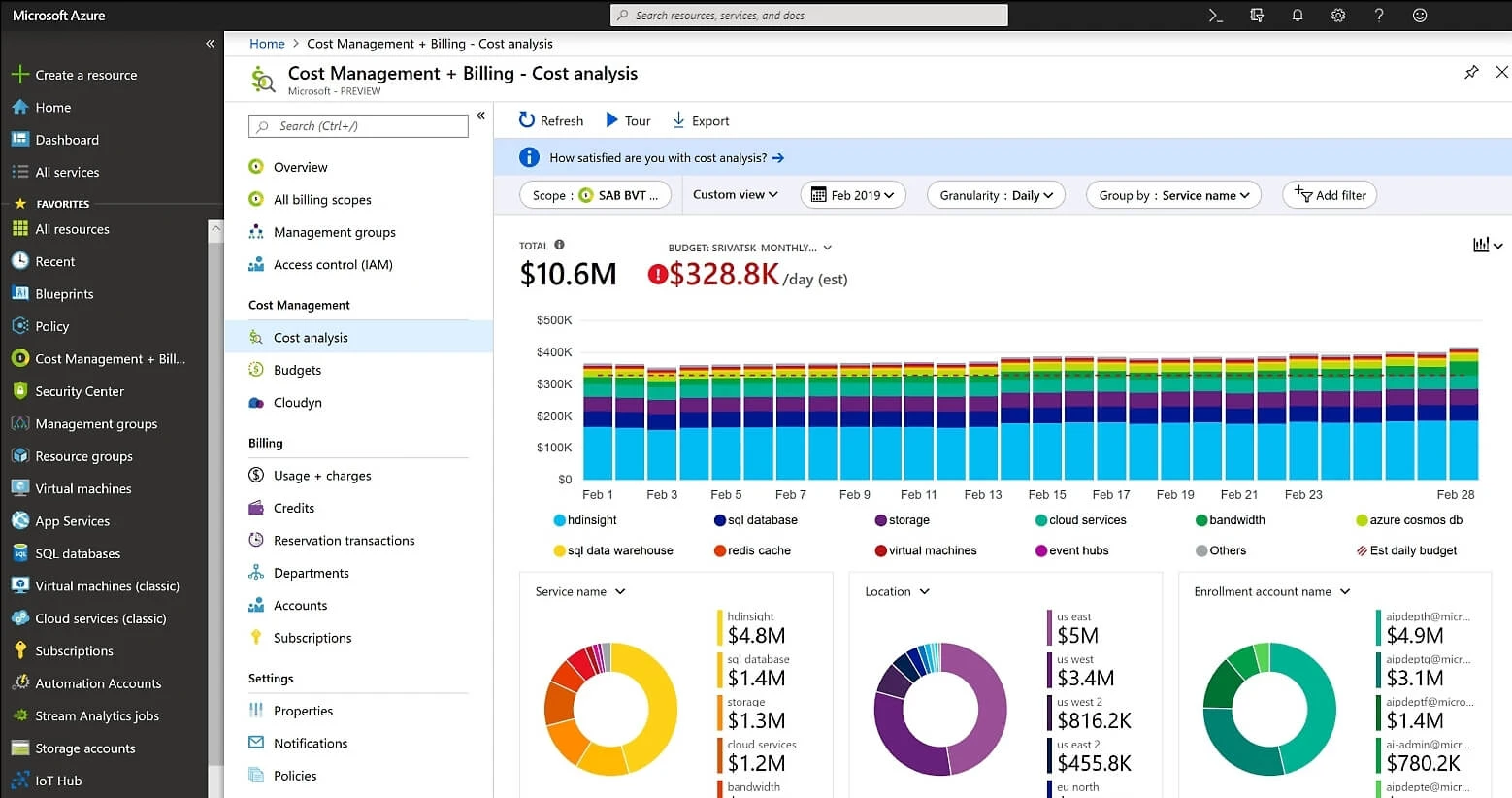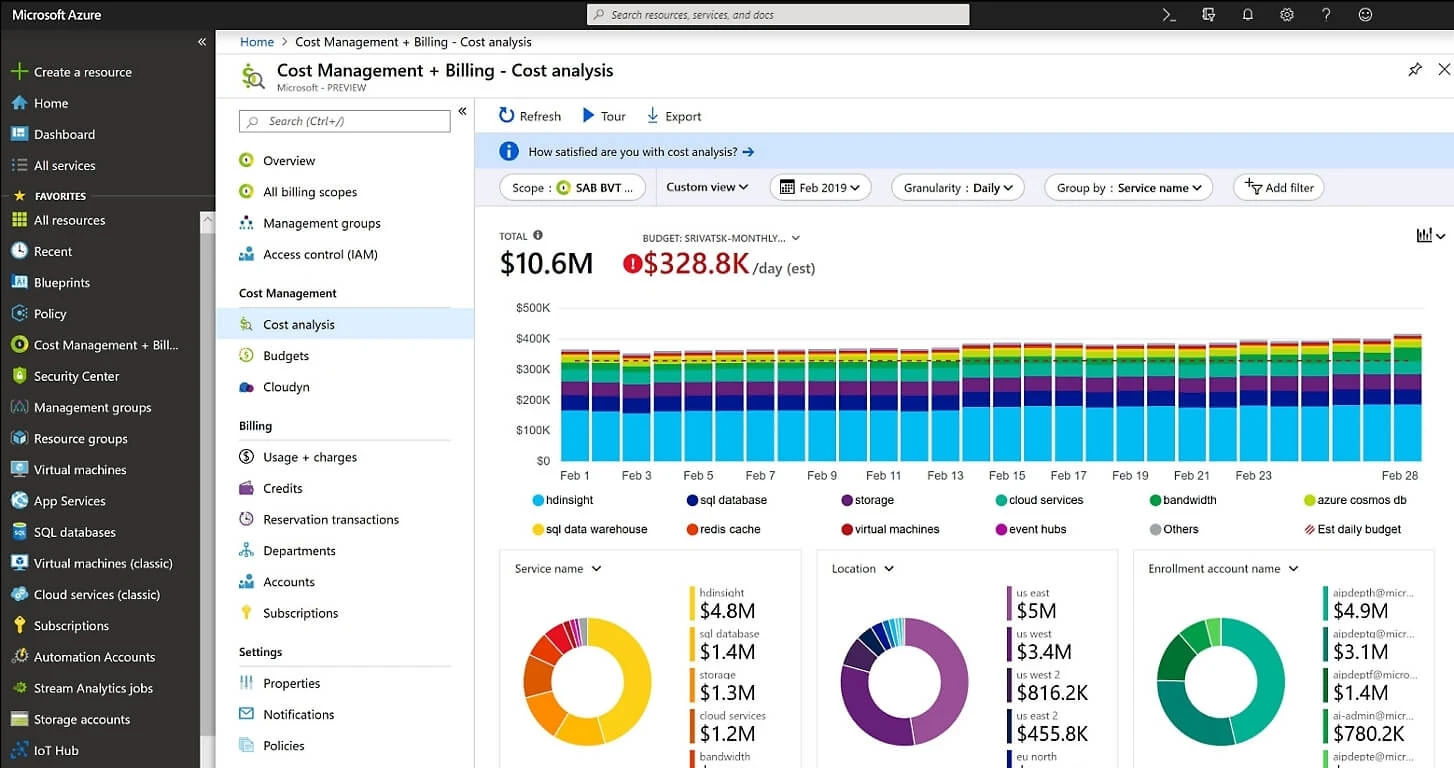Cost management can be challenging for organisations that lack the necessary skillset to keep on top of optimisation. In this article, we will explore how you can achieve financial efficiency with Azure Cost Management tooling provided by Microsoft Azure.
We will discuss users' challenges with Azure Cost Management, such as managing complexity, consolidating costs across multiple subscriptions, and gaining visibility into third-party service costs.
Cost management can be challenging for organisations that lack the necessary skillset to keep on top of optimisation.
Furthermore, we will provide strategies for cost optimisation, including monitoring resource usage, leveraging cost recommendations, setting cost budgets, and exploring Azure reserved instances.
Let's dive into the world of Azure Cost Management and discover how you can optimise your cloud costs and achieve financial efficiency!
What is Azure Cost Management?
Azure Cost Management is a powerful tool provided by Microsoft Azure that allows users to effectively track and manage their cloud costs. With Azure Cost Management, organisations can gain valuable insights into resource usage and cost trends and receive recommendations for optimising costs. This tool is essential for achieving financial efficiency and controlling cloud expenses.

Challenges with Azure Cost Management
While Azure Cost Management offers many benefits, there are a few challenges that users may encounter. These challenges include:
- Complexity: Managing cloud costs can be complex, especially in large organisations or environments with numerous resources. Azure Cost Management provides a comprehensive set of features and capabilities that may require expertise and time to fully understand and utilize.
- Multiple Azure Subscriptions: Organisations with multiple Azure subscriptions may face difficulties in consolidating and analyzing costs across all subscriptions. Additional configuration and setup may be required to ensure accurate and comprehensive cost visibility.
- Third-Party Service Integration: Azure Cost Management primarily focuses on Azure resource costs and may not provide full visibility into costs associated with third-party services or solutions integrated with Azure. Users may need to explore additional tools or methods to track and manage costs for these services effectively.
- Dynamic Nature of Cloud Environments: Cloud environments are dynamic, with resources being provisioned and de-provisioned as needed. Keeping track of resource changes and their impact on costs can be challenging. Regular monitoring and adjustment of cost management strategies are necessary to adapt to the changing nature of cloud environments.
- Limited Granularity: Azure Cost Management provides cost visibility and analysis based on predefined dimensions such as resource type, location, or tags. Users may find limitations in analysing costs at a more granular level or based on custom dimensions specific to their organisation.
To overcome these challenges, organisations should leverage documentation, training resources, and support from Microsoft Azure. Additionally, seeking assistance from Azure Cost Management experts or consultants can help optimise cost management practices and address unique challenges.
What can affect Azure's costs?
Several factors can impact Azure costs:
- Resource Usage: The amount of resources used, such as virtual machines, storage, and networking, can directly affect costs. Higher usage or running resource-intensive workloads can result in increased expenses.
- Instance Size and Configuration: The size and configuration of Azure instances, such as virtual machines, can impact costs. Choosing larger or more powerful instances often leads to higher costs.
- Storage Usage: The amount of data stored in Azure storage services, such as Blob storage or Azure Data Lake Storage, can impact costs. Storing large amounts of data or utilising premium storage options can increase expenses.
- Data Transfer: Transferring data in and out of Azure services, such as data transfer between regions or data transfer outside the Azure network, can incur costs. Higher data transfer volumes or using premium data transfer options can contribute to increased expenses.
- Service Usage: Utilising specific Azure services, such as Azure Machine Learning, Azure SQL Database, or Azure Cosmos DB, may come with additional costs based on usage or specific pricing models.
- Reserved Resources: Azure offers reserved instances or reserved capacity options for services like virtual machines, SQL Database, or Cosmos DB. Utilising reserved resources can provide cost savings compared to on-demand pricing.
- Geographical Region: The geographical region in which resources are provisioned can impact costs. Different regions may have varying pricing structures, and data transfer costs can differ based on the location of resources.
- Service-Level Agreements: Opting for higher service-level agreements (SLAs) or premium support options may result in higher costs compared to standard support options.
- Third-Party Solutions: Integrating third-party solutions or services with Azure can incur additional costs. Licensing fees or usage-based pricing models for these solutions can impact overall costs.
It is important to regularly monitor and optimize Azure costs using Azure Cost Management, analysing resource usage, and implement cost optimisation strategies to ensure efficient resource allocation and cost control.
Benefits of Microsoft Azure Cost Management
There are several benefits to utilising Microsoft Azure Cost Management:
- Cost Visibility: Azure Cost Management provides detailed insights into resource usage and cost trends, enabling users to understand where their cloud costs originate.
- Cost Optimization: The tool offers recommendations for optimising costs, helping users identify and implement cost-saving measures effectively.
- Budget Management: Users can set budgets and receive alerts when costs exceed predefined thresholds, empowering them to proactively manage their spending.
- Financial Accountability: Azure Cost Management helps organisations effectively manage and control their cloud expenses, promoting financial accountability and cost-conscious decision-making.
- Integration with Azure: As a native tool provided by Microsoft Azure, Azure Cost Management seamlessly integrates with other Azure services, making it easy to monitor and manage costs within the Azure environment.
These benefits make Azure Cost Management an indispensable tool for organisations looking to optimise their cloud costs and ensure efficient resource allocation.
Why consider Azure Cost Management?
There are several reasons why organizations should consider Azure Cost Management:
- Cost Visibility: Azure Cost Management provides detailed insights into resource usage and cost trends, enabling users to understand where their cloud costs are coming from. This visibility allows organisations to make informed decisions about cost optimisation.
- Cost Optimisation: Azure Cost Management offers recommendations for optimising costs. By leveraging these recommendations, organisations can identify and implement cost-saving measures, such as rightsizing resources or leveraging reserved instances.
- Budget Management: Azure Cost Management allows users to set budgets and receive alerts when costs exceed predefined thresholds. This proactive approach helps organizations manage their spending and stay within their financial targets.
- Financial Accountability: Azure Cost Management helps organisations effectively manage and control their cloud expenses. Promoting financial accountability and cost-conscious decision-making ensures that cloud investments are optimised and aligned with business goals.
- Integration with Azure: Azure Cost Management seamlessly integrates with other Azure services, providing a centralised platform for cost management. This integration simplifies the monitoring and management of costs within the Azure environment.
By considering Azure Cost Management, organisations can gain better visibility into their costs, optimise their cloud spending, and achieve more efficient resource allocation.
How to Optimise Azure Costs with Azure Cost Management
Azure Cost Management is a powerful tool provided by Microsoft Azure that allows users to effectively track and manage their cloud costs.
To optimise Azure costs with Azure Cost Management, follow these strategies:
- Monitor Resource Usage: Regularly monitor resource usage and identify any underutilised or idle resources. Consider scaling down or decommissioning such resources to reduce costs.
- Leverage Cost Recommendations: Take advantage of the cost recommendations provided by Azure Cost Management. Implement recommended actions, such as rightsizing virtual machines or using reserved instances, to optimise costs.
- Set Cost Budgets: Set cost budgets in Azure Cost Management to track spending against predefined limits. Receive alerts when costs exceed the budget to take timely actions.
- Use Azure Advisor: Utilise Azure Advisor, a service that provides personalised recommendations to optimise your Azure resources. It helps identify opportunities to improve performance, security, and cost efficiency.
- Explore Azure Reserved VM Instances: Consider purchasing Azure Reserved VM Instances for long-term workload commitments. This can result in significant cost savings compared to on-demand pricing.
- Implement Tagging and Resource Grouping: Utilise tags and resource grouping features in Azure Cost Management to gain better visibility and categorise resources for cost analysis and optimisation.
- Leverage Azure Hybrid Benefit: If you have existing on-premises licenses, take advantage of Azure Hybrid Benefit to apply the on-premises license cost savings to your Azure workloads.
- Regularly Review and Optimise: Continuously review cost reports, usage data, and cost-saving recommendations in Azure Cost Management. Regularly optimise your resources and cost management strategies based on insights gained.
By following these best practices and utilising Azure Cost Management effectively, organisations can optimise their Azure costs and achieve better cost efficiency in their cloud environment

Azure Cost Optimisation With Cost Management and Related Tools
Azure Cost Management offers various tools and features to optimise Azure costs. Some of these tools include:
Cost Analysis Report
The Cost Analysis Report in Azure Cost Management provides detailed insights into resource usage and cost trends. Users can analyse their cloud costs based on dimensions such as resource type, location, or tags. By understanding where costs come from, users can identify areas for optimisation and take necessary actions to reduce expenses.
Azure Budgets
Azure Budgets in Azure Cost Management enable users to set spending limits and receive alerts when costs exceed predefined thresholds. By setting budgets, organisations can proactively manage their spending and ensure they stay within their financial targets. Azure Budgets also provide flexibility in setting multiple budget scopes and timeframes to align with different cost management needs.
By considering Azure Cost Management, organizations can gain better visibility into their costs, optimise their cloud spending, and achieve more efficient resource allocation
Azure Pricing Calculator
The Azure Pricing Calculator is a valuable tool that helps users estimate and compare the costs of Azure services. Users can select desired services and configurations and receive an estimated cost breakdown based on the options. The Azure Pricing Calculator aids in planning and budgeting decisions, enabling users to make informed choices about their Azure resource selection.
Azure Advisor
Azure Advisor is a service that provides personalised recommendations to optimise Azure resources. It analyses resource configurations, usage patterns, and best practices to identify opportunities for improving performance, security, and cost efficiency. Azure Advisor recommendations cover virtual machine sizing, availability, security, and cost optimisation. By following these recommendations, users can optimise their Azure costs and enhance resource utilisation.
Best Practices for Azure Cost Management
To effectively manage Azure costs, follow these best practices:
- Regularly Monitor Resource Usage: Keep track of resource usage and identify any underutilised or idle resources. Scaling down or decommissioning such resources can reduce costs.
- Leverage Cost Recommendations: Take advantage of the cost recommendations provided by Azure Cost Management. Implement recommended actions, such as rightsizing virtual machines or using reserved instances, to optimise costs.
- Set Cost Budgets: Set budgets in Azure Cost Management to track spending against predefined limits. Receive alerts when costs exceed the budget to take timely actions.
- Use Azure Advisor: Utilise Azure Advisor to access personalised recommendations for optimising Azure resources. Implementing these recommendations can improve performance, security, and cost efficiency.
- Explore Azure Reserved VM Instances: Consider utilising Azure Reserved VM Instances for long-term workload commitments. This can lead to significant cost savings compared to on-demand pricing.
- Implement Tagging and Resource Grouping: Leverage tags and resource grouping features in Azure Cost Management to gain better visibility and categorise resources for cost analysis and optimisation.
- Leverage Azure Hybrid Benefit: If you have on-premises licenses, take advantage of Azure Hybrid Benefit to apply on-premises license cost savings to your Azure workloads.
- Regularly Review and Optimize: Continuously review cost reports, usage data, and cost-saving recommendations in Azure Cost Management. Regular optimisation of resources and cost management strategies based on insights gained is essential.
By following these best practices, organisations can effectively manage their Azure costs, optimise spending, and achieve better cost efficiency.
Managed Service Provider for Azure Cost Management
Partnering with a Managed Service Provider (MSP) like GrowCreate for Azure Cost Management offers several advantages:
- Expertise and Experience: MSPs specialise in managing and optimising cloud costs. They have extensive knowledge and experience working with Azure Cost Management and related tools. By leveraging their expertise, you can ensure cost management practices align with industry best practices and optimise cloud spending effectively.
- Cost Savings: MSPs identify cost-saving opportunities specific to an organisation's needs. They have insights into cost optimisation strategies, such as rightsizing resources, leveraging reserved instances, and implementing cost-effective architectures. Partnering with an MSP maximises cost savings and achieves better return on investment (ROI) from Azure investments.
- Proactive Monitoring and Optimisation: MSPs continuously monitor Azure costs and identify areas for optimisation. They proactively adjust resource configurations, apply cost management best practices, and provide recommendations to optimise cloud spending. This ensures organisations stay on top of cost management.









